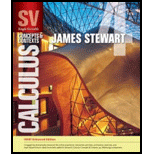
Concept explainers
The rate of the removal.
Answer to Problem 8P
The dog never catches the rabbit.
Explanation of Solution
Given information:
Snow began to fall during the morning of February 2 and continued steadily into the afternoon. At noon a snow plow began removing snow from a road at a constant rate. The plow traveled 6 km from noon to 1 PM out only 3 km from 1 PM to 2 PM. When did the snow begin to fall?
Formula used:
Calculation:
The distance travelled by the dog from point (L, 0) to (0, s) is given by the following equation.
The speed of the dog is twice the speed of the rabbit it means position of the rabbit when dog has travelled the distance s is
Here the dog runs in a Straight line to catch the rabbit, so the rate of change of y with respect to x is the slope of the line joining the points
Equate the expressions for
Hence the desired differential equation is
Solve the differential equation
Let
Now put these values in the differential equation
This equation can be solved by separating the variables and then by integrating it
When
Put
Now solve this equation for Z.
Since,
Now solve these equations one by one separately.
Here
So,
Put this value into the equation
Hence the solution to the differential equation
Solve the second equation
It can be rewritten as
Hence solution to equation will be
Here
Put this value into the equation
Hence the solution to the differential equation
Evaluate the
Use either of the equations
Hence dog catches the rabbit at distance of
The distance travelled by the dog from point (L, 0) to (0, 5) is given by the following equation.
The speed of the dog is half the speed of the rabbit it means position of the rabbit when dog has travelled the distance sis (0,2s).
Here the dog runs in a straight line to catch the rabbit, so the rate of change of y with respect to x is the slope of the line joining the points (0, 2s), (x, y).
Equate the expressions for
Hence the desired differential equation is
Solve the differential equation
Let
Now put these values in the differential equation
This equation can be solved by separating the variables and then by integrating it
When
Put
Now solve this equation for Z.
Since,
Here
So
Hence the solution to the differential equation
Evaluate the limit
Use the equation
Hence dog never catches the rabbit.
Conclusion:
The dog never catches the rabbit.
Chapter 7 Solutions
Single Variable Calculus: Concepts and Contexts, Enhanced Edition
- Find the Soultion to the following dy differential equation using Fourier in transforms: = , хуо, ухо according to the terms: lim u(x,y) = 0 x18 lim 4x (x,y) = 0 x14 2 u (x, 0) = =\u(o,y) = -y لوarrow_forwardCan you solve question 3,4,5 and 6 for this questionarrow_forwardwater at a rate of 2 m³/min. of the water height in this tank? 16) A box with a square base and an open top must have a volume of 256 cubic inches. Find the dimensions of the box that will minimize the amount of material used (the surface area). 17) A farmer wishes toarrow_forward
- #14 Sand pours from a chute and forms a conical pile whose height is always equal to its base diameter. The height o the pile increases at a rate of 5 feet/hour. Find the rate of change of the volume of the sand in the conical pile when the height of the pile is 4 feet.arrow_forward(d)(65in(x)-5 cos(x) dx mins by 5x-2x² 3x+1 dx -dx 20 Evaluate each the following indefinite integralsarrow_forward19 Evaluate each the following definite integrals: a) લ b) (+3) 6) (2-2)(+33) dxarrow_forward
- #11 If a snowball melts so its surface area decreases at a rate of 1cm²/min, find the rate at which the diameter decreases when the diameter is 6 cm.arrow_forwardUse Deritivitve of the inverse to solve thisarrow_forwardEvaluate the following Limits: e6x-1 Lim +0Sin3x 7x-5x2 2x-1+ Cos 4x +6 c) Lim b) Lim + x³-x2 X-0 1-e' 4x d) Lim 6x²-3 X+0 6x+2x² Find the derivatives of the following functions using the Limit definition of derivativearrow_forward
- 15A cylindrical tank with radius 8 m is being filled with water at a rate of 2 m³/min. What is the rate of change of the water height in this tank? 6)A box with a square base and an open top must box that will minimiarrow_forward#12 The radius of a sphere increases at a rate of 3 in/sec. How fast is the volume increasing when the diameter is 24arrow_forward84 256 cubic inches. Find the dimensions of the of material used (the surface area). A farmer wishes to enclose a rectangular plot using 200 m of fencing material. One side of the land borders a river and does not need fencing. What is the largest area that can be enclosed? For the function y=x³-3x²-1, use derivatives to: 3 b) 2x - 6x2 (a) determine the intarrow_forward
 Calculus: Early TranscendentalsCalculusISBN:9781285741550Author:James StewartPublisher:Cengage Learning
Calculus: Early TranscendentalsCalculusISBN:9781285741550Author:James StewartPublisher:Cengage Learning Thomas' Calculus (14th Edition)CalculusISBN:9780134438986Author:Joel R. Hass, Christopher E. Heil, Maurice D. WeirPublisher:PEARSON
Thomas' Calculus (14th Edition)CalculusISBN:9780134438986Author:Joel R. Hass, Christopher E. Heil, Maurice D. WeirPublisher:PEARSON Calculus: Early Transcendentals (3rd Edition)CalculusISBN:9780134763644Author:William L. Briggs, Lyle Cochran, Bernard Gillett, Eric SchulzPublisher:PEARSON
Calculus: Early Transcendentals (3rd Edition)CalculusISBN:9780134763644Author:William L. Briggs, Lyle Cochran, Bernard Gillett, Eric SchulzPublisher:PEARSON Calculus: Early TranscendentalsCalculusISBN:9781319050740Author:Jon Rogawski, Colin Adams, Robert FranzosaPublisher:W. H. Freeman
Calculus: Early TranscendentalsCalculusISBN:9781319050740Author:Jon Rogawski, Colin Adams, Robert FranzosaPublisher:W. H. Freeman
 Calculus: Early Transcendental FunctionsCalculusISBN:9781337552516Author:Ron Larson, Bruce H. EdwardsPublisher:Cengage Learning
Calculus: Early Transcendental FunctionsCalculusISBN:9781337552516Author:Ron Larson, Bruce H. EdwardsPublisher:Cengage Learning





